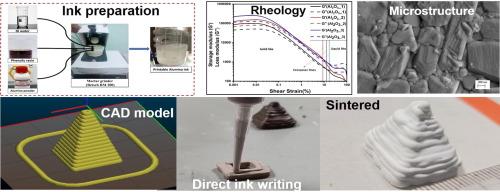直接墨水书写法制备氧化铝锥体的结构-性能关系
IF 2
Q3 ENGINEERING, MANUFACTURING
引用次数: 0
摘要
直接墨水书写(DIW)技术打印氧化铝金字塔。油墨配方包括使用纯氧化铝粉、酚醛树脂和去离子水。固体负载为64 vol%的氧化铝墨水为3D打印提供了合适的流变特性。将合成的油墨用于金字塔体的3D打印,并在不同温度(1500℃- 1600℃)下烧结。1600℃烧结后的试样组织致密(98%),具有良好的抗弯强度(308.34±10 MPa)和中等的断裂韧性(4.01±0.4 MPa)。m1/2),高硬度(1625hv)。本文章由计算机程序翻译,如有差异,请以英文原文为准。

Structure-property correlation of alumina pyramidoids fabricated by direct ink writing
The direct ink writing (DIW) technique prints alumina Pyramidoids. Ink formulation included the usage of pure alumina powder, phenolic resin, and deionized water. Alumina ink with a solid loading of 64 vol% provides suitable rheological properties for 3D printing. The synthesized ink was used for 3D printing of a pyramidoid and sintering at different temperatures (1500 °C–1600 °C). The sample sintered at 1600 °C exhibits a dense microstructure (98 %), good flexural strength (308.34 ± 10 MPa), moderate fracture toughness (4.01 ± 0.4 MPa.m1/2), and high hardness (1625 HV).
求助全文
通过发布文献求助,成功后即可免费获取论文全文。
去求助
来源期刊

Manufacturing Letters
Engineering-Industrial and Manufacturing Engineering
CiteScore
4.20
自引率
5.10%
发文量
192
审稿时长
60 days
 求助内容:
求助内容: 应助结果提醒方式:
应助结果提醒方式:


